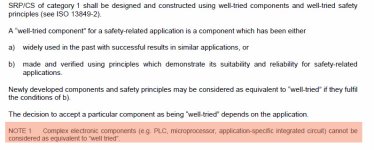JeremyAdair87
Member
I am having a bit of trouble with mechanical engineers and safety.
They are doing things like saying "a light curtain is being used as a "go button"" while an operator sticks their hands in a live mill for part placement after incorrectly removing the safety door and "reducing its cycle time" by putting an automatic door with a 200 lb slide on it. Its pretty much a guillotine and is held out by a logic output.
We have two touch buttons that keep people's hands out of a small 85psi press. The two touches are again "a go button" so the operator can work in the rest of the cell, however the press is a major pinch point. The two touches were bypassed to "reduce cycle time" so the operator can work on other items in the cell which has 5 or 6 operations based around a mill.
We have safety devices going to PLC inputs. They want code that bypasses safety... Safety is done with electrically wired devices and not code.
First I need to study the codebook more but quickly I need help finding the osha, IEC, or NEC lines defining that it is not okay to do these things. I have used the NFPA 70E Risk assessment documentation, and clarified that injuries at the plant are the fault of the plant, and that we need to identify any hazard and determine probability of occurrence, injury, frequency of exposure, and likelihood of avoidance. "IT IS ON US to engineer IT", I say!

.... but the plant is says "it is not likely" we "can not increase cycle time" and "lets band aid this safety and make it slightly less risky and HOPE the operator doesn't stick their finger in that press again"... Murphy's law says they are going to stick their finger in it again and it is going to go to corporate that the machine "we made safe" is still hurting people.
It has been a long day. Thanks for listening.
They are doing things like saying "a light curtain is being used as a "go button"" while an operator sticks their hands in a live mill for part placement after incorrectly removing the safety door and "reducing its cycle time" by putting an automatic door with a 200 lb slide on it. Its pretty much a guillotine and is held out by a logic output.
We have two touch buttons that keep people's hands out of a small 85psi press. The two touches are again "a go button" so the operator can work in the rest of the cell, however the press is a major pinch point. The two touches were bypassed to "reduce cycle time" so the operator can work on other items in the cell which has 5 or 6 operations based around a mill.
We have safety devices going to PLC inputs. They want code that bypasses safety... Safety is done with electrically wired devices and not code.
First I need to study the codebook more but quickly I need help finding the osha, IEC, or NEC lines defining that it is not okay to do these things. I have used the NFPA 70E Risk assessment documentation, and clarified that injuries at the plant are the fault of the plant, and that we need to identify any hazard and determine probability of occurrence, injury, frequency of exposure, and likelihood of avoidance. "IT IS ON US to engineer IT", I say!
.... but the plant is says "it is not likely" we "can not increase cycle time" and "lets band aid this safety and make it slightly less risky and HOPE the operator doesn't stick their finger in that press again"... Murphy's law says they are going to stick their finger in it again and it is going to go to corporate that the machine "we made safe" is still hurting people.
It has been a long day. Thanks for listening.





